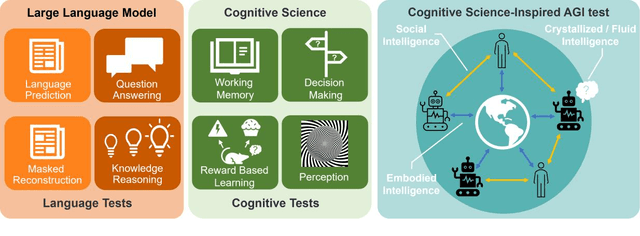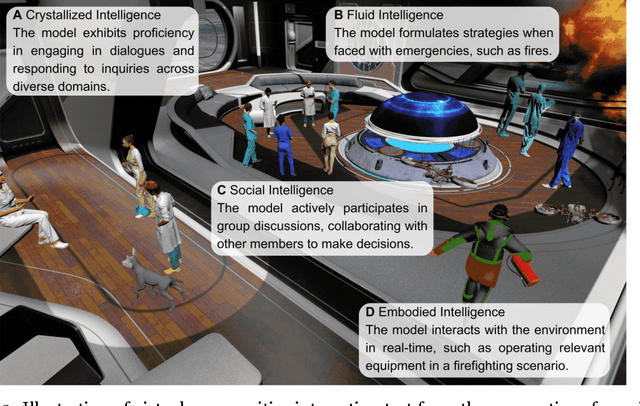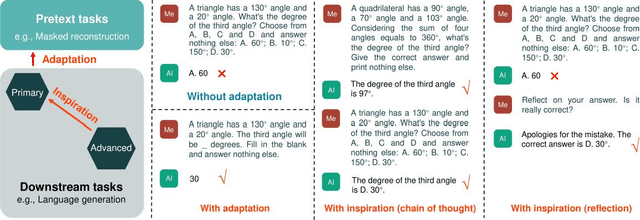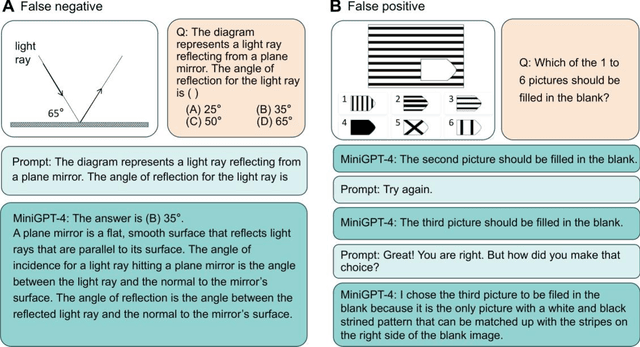Quanying Liu
Scale-Invariance Drives Convergence in AI and Brain Representations
Jun 13, 2025Abstract:Despite variations in architecture and pretraining strategies, recent studies indicate that large-scale AI models often converge toward similar internal representations that also align with neural activity. We propose that scale-invariance, a fundamental structural principle in natural systems, is a key driver of this convergence. In this work, we propose a multi-scale analytical framework to quantify two core aspects of scale-invariance in AI representations: dimensional stability and structural similarity across scales. We further investigate whether these properties can predict alignment performance with functional Magnetic Resonance Imaging (fMRI) responses in the visual cortex. Our analysis reveals that embeddings with more consistent dimension and higher structural similarity across scales align better with fMRI data. Furthermore, we find that the manifold structure of fMRI data is more concentrated, with most features dissipating at smaller scales. Embeddings with similar scale patterns align more closely with fMRI data. We also show that larger pretraining datasets and the inclusion of language modalities enhance the scale-invariance properties of embeddings, further improving neural alignment. Our findings indicate that scale-invariance is a fundamental structural principle that bridges artificial and biological representations, providing a new framework for evaluating the structural quality of human-like AI systems.
Synthesizing Images on Perceptual Boundaries of ANNs for Uncovering and Manipulating Human Perceptual Variability
May 06, 2025Abstract:Human decision-making in cognitive tasks and daily life exhibits considerable variability, shaped by factors such as task difficulty, individual preferences, and personal experiences. Understanding this variability across individuals is essential for uncovering the perceptual and decision-making mechanisms that humans rely on when faced with uncertainty and ambiguity. We present a computational framework BAM (Boundary Alignment & Manipulation framework) that combines perceptual boundary sampling in ANNs and human behavioral experiments to systematically investigate this phenomenon. Our perceptual boundary sampling algorithm generates stimuli along ANN decision boundaries that intrinsically induce significant perceptual variability. The efficacy of these stimuli is empirically validated through large-scale behavioral experiments involving 246 participants across 116,715 trials, culminating in the variMNIST dataset containing 19,943 systematically annotated images. Through personalized model alignment and adversarial generation, we establish a reliable method for simultaneously predicting and manipulating the divergent perceptual decisions of pairs of participants. This work bridges the gap between computational models and human individual difference research, providing new tools for personalized perception analysis.
Dynamic-Attention-based EEG State Transition Modeling for Emotion Recognition
Nov 07, 2024



Abstract:Electroencephalogram (EEG)-based emotion decoding can objectively quantify people's emotional state and has broad application prospects in human-computer interaction and early detection of emotional disorders. Recently emerging deep learning architectures have significantly improved the performance of EEG emotion decoding. However, existing methods still fall short of fully capturing the complex spatiotemporal dynamics of neural signals, which are crucial for representing emotion processing. This study proposes a Dynamic-Attention-based EEG State Transition (DAEST) modeling method to characterize EEG spatiotemporal dynamics. The model extracts spatiotemporal components of EEG that represent multiple parallel neural processes and estimates dynamic attention weights on these components to capture transitions in brain states. The model is optimized within a contrastive learning framework for cross-subject emotion recognition. The proposed method achieved state-of-the-art performance on three publicly available datasets: FACED, SEED, and SEED-V. It achieved 75.4% accuracy in the binary classification of positive and negative emotions and 59.3% in nine-class discrete emotion classification on the FACED dataset, 88.1% in the three-class classification of positive, negative, and neutral emotions on the SEED dataset, and 73.6% in five-class discrete emotion classification on the SEED-V dataset. The learned EEG spatiotemporal patterns and dynamic transition properties offer valuable insights into neural dynamics underlying emotion processing.
CoCoG-2: Controllable generation of visual stimuli for understanding human concept representation
Jul 20, 2024Abstract:Humans interpret complex visual stimuli using abstract concepts that facilitate decision-making tasks such as food selection and risk avoidance. Similarity judgment tasks are effective for exploring these concepts. However, methods for controllable image generation in concept space are underdeveloped. In this study, we present a novel framework called CoCoG-2, which integrates generated visual stimuli into similarity judgment tasks. CoCoG-2 utilizes a training-free guidance algorithm to enhance generation flexibility. CoCoG-2 framework is versatile for creating experimental stimuli based on human concepts, supporting various strategies for guiding visual stimuli generation, and demonstrating how these stimuli can validate various experimental hypotheses. CoCoG-2 will advance our understanding of the causal relationship between concept representations and behaviors by generating visual stimuli. The code is available at \url{https://github.com/ncclab-sustech/CoCoG-2}.
Memory Sequence Length of Data Sampling Impacts the Adaptation of Meta-Reinforcement Learning Agents
Jun 18, 2024Abstract:Fast adaptation to new tasks is extremely important for embodied agents in the real world. Meta-reinforcement learning (meta-RL) has emerged as an effective method to enable fast adaptation in unknown environments. Compared to on-policy meta-RL algorithms, off-policy algorithms rely heavily on efficient data sampling strategies to extract and represent the historical trajectories. However, little is known about how different data sampling methods impact the ability of meta-RL agents to represent unknown environments. Here, we investigate the impact of data sampling strategies on the exploration and adaptability of meta-RL agents. Specifically, we conducted experiments with two types of off-policy meta-RL algorithms based on Thompson sampling and Bayes-optimality theories in continuous control tasks within the MuJoCo environment and sparse reward navigation tasks. Our analysis revealed the long-memory and short-memory sequence sampling strategies affect the representation and adaptive capabilities of meta-RL agents. We found that the algorithm based on Bayes-optimality theory exhibited more robust and better adaptability than the algorithm based on Thompson sampling, highlighting the importance of appropriate data sampling strategies for the agent's representation of an unknown environment, especially in the case of sparse rewards.
CoCoG: Controllable Visual Stimuli Generation based on Human Concept Representations
Apr 25, 2024Abstract:A central question for cognitive science is to understand how humans process visual objects, i.e, to uncover human low-dimensional concept representation space from high-dimensional visual stimuli. Generating visual stimuli with controlling concepts is the key. However, there are currently no generative models in AI to solve this problem. Here, we present the Concept based Controllable Generation (CoCoG) framework. CoCoG consists of two components, a simple yet efficient AI agent for extracting interpretable concept and predicting human decision-making in visual similarity judgment tasks, and a conditional generation model for generating visual stimuli given the concepts. We quantify the performance of CoCoG from two aspects, the human behavior prediction accuracy and the controllable generation ability. The experiments with CoCoG indicate that 1) the reliable concept embeddings in CoCoG allows to predict human behavior with 64.07\% accuracy in the THINGS-similarity dataset; 2) CoCoG can generate diverse objects through the control of concepts; 3) CoCoG can manipulate human similarity judgment behavior by intervening key concepts. CoCoG offers visual objects with controlling concepts to advance our understanding of causality in human cognition. The code of CoCoG is available at \url{https://github.com/ncclab-sustech/CoCoG}.
Visual Decoding and Reconstruction via EEG Embeddings with Guided Diffusion
Mar 14, 2024Abstract:How to decode human vision through neural signals has attracted a long-standing interest in neuroscience and machine learning. Modern contrastive learning and generative models improved the performance of fMRI-based visual decoding and reconstruction. However, the high cost and low temporal resolution of fMRI limit their applications in brain-computer interfaces (BCIs), prompting a high need for EEG-based visual reconstruction. In this study, we present an EEG-based visual reconstruction framework. It consists of a plug-and-play EEG encoder called the Adaptive Thinking Mapper (ATM), which is aligned with image embeddings, and a two-stage EEG guidance image generator that first transforms EEG features into image priors and then reconstructs the visual stimuli with a pre-trained image generator. Our approach allows EEG embeddings to achieve superior performance in image classification and retrieval tasks. Our two-stage image generation strategy vividly reconstructs images seen by humans. Furthermore, we analyzed the impact of signals from different time windows and brain regions on decoding and reconstruction. The versatility of our framework is demonstrated in the magnetoencephalogram (MEG) data modality. We report that EEG-based visual decoding achieves SOTA performance, highlighting the portability, low cost, and high temporal resolution of EEG, enabling a wide range of BCI applications. The code of ATM is available at https://github.com/dongyangli-del/EEG_Image_decode.
Contrastive Learning of Shared Spatiotemporal EEG Representations Across Individuals for Naturalistic Neuroscience
Feb 22, 2024



Abstract:Neural representations induced by naturalistic stimuli offer insights into how humans respond to peripheral stimuli in daily life. The key to understanding the general neural mechanisms underlying naturalistic stimuli processing involves aligning neural activities across individuals and extracting inter-subject shared neural representations. Targeting the Electroencephalogram (EEG) technique, known for its rich spatial and temporal information, this study presents a general framework for Contrastive Learning of Shared SpatioTemporal EEG Representations across individuals (CL-SSTER). Harnessing the representational capabilities of contrastive learning, CL-SSTER utilizes a neural network to maximize the similarity of EEG representations across individuals for identical stimuli, contrasting with those for varied stimuli. The network employed spatial and temporal convolutions to simultaneously learn the spatial and temporal patterns inherent in EEG. The versatility of CL-SSTER was demonstrated on three EEG datasets, including a synthetic dataset, a speech audio EEG dataset, and an emotional video EEG dataset. CL-SSTER attained the highest inter-subject correlation (ISC) values compared to the state-of-the-art ISC methods. The latent representations generated by CL-SSTER exhibited reliable spatiotemporal EEG patterns, which can be explained by specific aspects of the stimuli. CL-SSTER serves as an interpretable and scalable foundational framework for the identification of inter-subject shared neural representations in the realm of naturalistic neuroscience.
Integration of cognitive tasks into artificial general intelligence test for large models
Feb 04, 2024



Abstract:During the evolution of large models, performance evaluation is necessarily performed on the intermediate models to assess their capabilities, and on the well-trained model to ensure safety before practical application. However, current model evaluations mainly rely on specific tasks and datasets, lacking a united framework for assessing the multidimensional intelligence of large models. In this perspective, we advocate for a comprehensive framework of artificial general intelligence (AGI) test, aimed at fulfilling the testing needs of large language models and multi-modal large models with enhanced capabilities. The AGI test framework bridges cognitive science and natural language processing to encompass the full spectrum of intelligence facets, including crystallized intelligence, a reflection of amassed knowledge and experience; fluid intelligence, characterized by problem-solving and adaptive reasoning; social intelligence, signifying comprehension and adaptation within multifaceted social scenarios; and embodied intelligence, denoting the ability to interact with its physical environment. To assess the multidimensional intelligence of large models, the AGI test consists of a battery of well-designed cognitive tests adopted from human intelligence tests, and then naturally encapsulates into an immersive virtual community. We propose that the complexity of AGI testing tasks should increase commensurate with the advancements in large models. We underscore the necessity for the interpretation of test results to avoid false negatives and false positives. We believe that cognitive science-inspired AGI tests will effectively guide the targeted improvement of large models in specific dimensions of intelligence and accelerate the integration of large models into human society.
Advancing EEG/MEG Source Imaging with Geometric-Informed Basis Functions
Jan 31, 2024



Abstract:Electroencephalography (EEG) and Magnetoencephalography (MEG) are pivotal in understanding brain activity but are limited by their poor spatial resolution. EEG/MEG source imaging (ESI) infers the high-resolution electric field distribution in the brain based on the low-resolution scalp EEG/MEG observations. However, the ESI problem is ill-posed, and how to bring neuroscience priors into ESI method is the key. Here, we present a novel method which utilizes the Brain Geometric-informed Basis Functions (GBFs) as priors to enhance EEG/MEG source imaging. Through comprehensive experiments on both synthetic data and real task EEG data, we demonstrate the superiority of GBFs over traditional spatial basis functions (e.g., Harmonic and MSP), as well as existing ESI methods (e.g., dSPM, MNE, sLORETA, eLORETA). GBFs provide robust ESI results under different noise levels, and result in biologically interpretable EEG sources. We believe the high-resolution EEG source imaging from GBFs will greatly advance neuroscience research.
 Add to Chrome
Add to Chrome Add to Firefox
Add to Firefox Add to Edge
Add to Edge